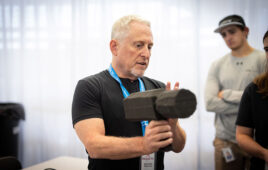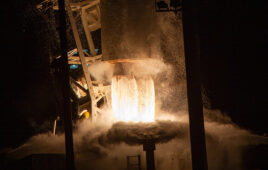 Flight history in Bremen, Germany, began more than a hundred years ago. Since then, this important northern German city has become well known as the second-largest aerospace hub in the country. Over the past several years, Bremen has established itself as a standard-bearer in aerospace R&D.
Flight history in Bremen, Germany, began more than a hundred years ago. Since then, this important northern German city has become well known as the second-largest aerospace hub in the country. Over the past several years, Bremen has established itself as a standard-bearer in aerospace R&D.
A growing network of Bremen-based organizations now play leading roles in the worldwide push to develop new space technologies. And in the process of making meaningful technological advances, these organizations are helping Europe remain a major player in the global space race.
More than just a small handful of space-related R&D organizations in Northern Germany have had significant breakthroughs over the past few years. Following are six of the many key developments worth noting:
- In 2021, the German Aerospace Center (DLR) launched the first two satellites of its new Earth observation constellation, the TanDEM-X Follow-On mission. These satellites are equipped with advanced radar instruments that will be used to create high-resolution images of Earth’s surface.
- In 2022, the European Space Agency (ESA) selected the DLR to lead the development of the next generation of space robots. These robots will be used for a variety of tasks in space, such as assembling and repairing satellites.
- In 2023, the University of Bremen launched the Bremen Institute for Space Systems (BISS). BISS is an important research institute focused on the development of innovative space technologies.
- DLR developed the SMART-1 lunar probe, which was the first European spacecraft to complete a Moon orbit.
- DLR and NASA developed the GRACE gravity gradiometry mission, which measures changes in Earth’s gravity field. (Gravity gradiometry is the study and measurement of variations or anomalies in the Earth’s gravity field.)
- ESA developed the LISA Pathfinder mission, which is a precursor to the LISA gravitational wave observatory.
These accomplishments are helping the global space R&D community see the emerging strength of advanced space science and technology underway in Northern Germany.
A look inside Bremen’s aerospace industry
Bremen’s aerospace industry comprises more than 140 companies and 20 institutes and employs over 12,000 people. The city has more space aeronautics and aerospace experts as a percentage of its population than anywhere else in Germany.
Airbus, OHB SE, ArianeGroup, and Rheinmetall Defence Electronics are just a few of the major industry players with a large Bremen base or a local origin story. Their products are needed all over the world, and they have attracted many small companies that set up as suppliers or startups.
Up to 4,500 people are employed at the Bremen Airbus site, which is home to the interdisciplinary platform for all Airbus high-lift systems. Flight physics, development, manufacturing, and assembly all happen at the Airbus plant at Bremen airport, where R&D is a major factor. The aircraft manufacturer’s current research projects include 3D printing of metal parts, testing of robots, and hydrogen-powered flight research specializing in hydrogen tank structure and cryogenics. One of the two ZEROe Development Centre research facilities of Airbus Group is located in Bremen.
The Franco-German joint venture ArianeGroup is involved in building the upper stage of the late Ariane 5 rocket. Its successor, the Ariane 6, is also made in Bremen and awaits its maiden flight.
For many years, Bremen engineers and scientists have been indispensable team members involved in global space exploration. The Columbus laboratory, which is Europe’s contribution to the International Space Station (ISS), and the ATV space shuttle used to supply the ISS were built here. Now, Bremen is constructing the European Service Module (ESM), which is part of NASA’s new Artemis Moon-landing mission. The ESM 3 is the first system-critical component of a major NASA project allowed to be developed and built outside the U.S. Before the end of this decade, the European Large Logistic Lander (EL3) will be the first large European space vehicle to land on the Moon to deliver and unload material for a future station. An initial concept is currently being created at Airbus.
Bremen-based OHB SE has about 1,000 employees and develops and tests the Galileo satellites of the European GPS system. Ten of the 14 Galileo satellites that are currently orbiting in space come from OHB SE. The company is also planning its own rocket station in the North Sea and is currently building a launch vehicle with its start-up Rocket Factory Augsburg.
Bremen is the convenor of “Space Tech Expo Europe” every November with guests from all over the world. ECOMAT, the Centre for Eco-efficient Materials and Technologies, opened its doors in early 2019 at Bremen Airport City. Lightweight engineering, material development, climate-neutral flying, manufacturing, and testing are consolidated here. The idea is for all partners to use each other’s laboratories and test rigs to discuss findings with each other and create new knowledge together — all under one roof.
Work is currently underway to expand the concept with the ECOMAT Hydrogen Campus. The new building focuses entirely on hydrogen applications across industries. It thus complements the numerous research activities in this field, which are intended to make Bremen a hydrogen hub in Northern Europe.
The Bremen region’s three universities of applied sciences provide homes for aeronautics and aerospace R&D. They also provide employers with a steady stream of highly qualified graduates. For example, two of the international space master’s degree programs — Space Sciences and Technologies (Space-ST) and Space Engineering (SpE) — are among the more popular academic offerings.
The emphasis is not only post-secondary: GymProLuR is an aerospace-focused school project. This is the fruit of a collaboration between the city’s secondary schools, the Bremen University of Applied Sciences, and the regional government. It enables teenagers to try out the industry while enrolled in secondary school. In addition, four Bremen schools help organize the German CanSat competition, which forms part of the European Space Agency’s international competition.
Bremen is now home to a wide range of up-and-coming tech startups and hosts the ESA Business Incubation Centre (BIC) Northern Germany. Aerospace startups are embedded in a functioning startup ecosystem with many public and private activities.
A variety of Bremen-based institutions, including the industry network Aviaspace Bremen, work closely together within the Bremen Aerospace Cluster. Its motto is “more innovation and competitive strength through cooperation in the aerospace industry.” The Cluster serves suppliers, production companies, and research institutions by acting as a local “mediator” linking up business, research, politics, and administration. The Cluster also represents Bremen’s interests in various working groups and creates tight bonds outside Germany through international associations.
Bremen’s compact size has always been one of its key strengths, and the short distances between its various institutions in industry, education, and science make it that much easier for them to work together. There are so many benefits to this geographical compactness, and Bremen now has two hubs of aerospace expertise: the shape of Bremen Airport City and the Technology Park.
Bremen Airport City, and the airport itself, are just a stone’s throw apart and a few minutes’ drive from Bremen city center. More than 500 companies employ roughly 16,500 people here, and ambitious new businesses in the startup center rub shoulders with global players such as Airbus.
Bremen Technology Park is one of Germany’s leading technology hubs. The German Research Centre for Artificial Intelligence (DFKI), German Aerospace Centre (DLR), Fraunhofer Institute, University of Bremen, and more than 15 other research institutes work side by side here on aerospace projects with commercial giants such as Siemens and OHB. At the heart of it all is the Fallturm drop tower, the park’s signature landmark and the only facility of its kind in Europe. It is used by the Centre of Applied Space Technology and Microgravity to test processes and materials in zero gravity.
Over the years, a number of leading companies have developed around the drop tower. One of these firms is Zarm Technik AG. It’s perfected the Torquer magnet, which worldwide organizations — including NASA’s Jet Propulsion Laboratory and Northrop Grumman — use to control satellite position.
A growing ecosystem of small and medium enterprises in Bremen produces highly specialized and sought-after products. These companies have become known to only a small group of industry experts, but their status as “hidden story” may soon be changing.
Lessons to learn
These are many outstanding German government programs and initiatives that successfully provide much-needed support R&D. Such programs help to keep Germany in its position as a global tech leader in various industries, such as manufacturing and transporting chemicals. They can provide a model for other countries and regions.
Germany is a global leader in research and development, spending 3.2% of its GDP on R&D in 2020. This is higher than the U.S. (2.8%) and Japan (3.1%). Germany’s success in R&D is due to a number of factors, including its government’s strong commitment and providing significant R&D funding through direct investment and tax breaks. Here are some specific lessons that U.S.-based R&D experts can learn from Germany’s example:
Focus on long-term goals — R&D is a long-term investment, and it takes time for research to translate into new products and services. The German government is willing to invest in R&D with a long-term view, even if the immediate benefits are not clear.
Foster collaboration — R&D is most effective when it is done in collaboration between different stakeholders. The German government encourages collaboration between industry, academia, and the public sector. This helps to ensure that research is relevant to the needs of the economy and society.
Create a supportive environment for innovation — The German government supports innovation through a variety of programs, such as incubators and accelerators. These programs help to nurture new businesses and make it easier for them to succeed.
Invest in basic research — Basic research is the foundation of innovation. The German government invests in basic research, even if it does not have immediate commercial applications. This helps to ensure that Germany has a strong pool of scientific talent and is at the forefront of new technologies.
In addition, the German government uses specific initiatives to support innovations in R&D:
- The Excellence Initiative: This program provides funding for world-class research universities in Germany.
- The German Research Foundation (DFG): This is the largest research funding organization in Germany. It funds research projects in all fields of science and humanities.
- The Federal Ministry of Education and Research (BMBF): This ministry is responsible for national R&D policy. It funds a wide range of research projects, including those in emerging technologies.
- The Fraunhofer Society: This is a non-profit research organization that conducts applied research in a variety of fields.
- The Max Planck Society: This is a non-profit research organization that conducts basic research in the natural sciences and humanities.





Availability of the network